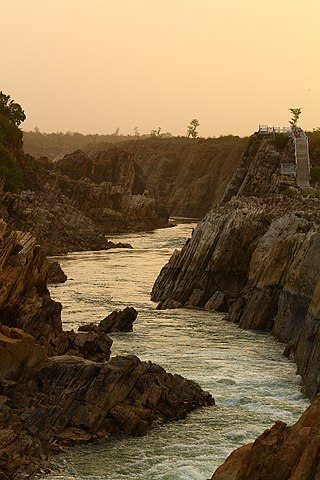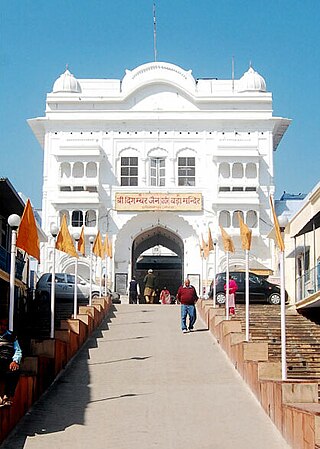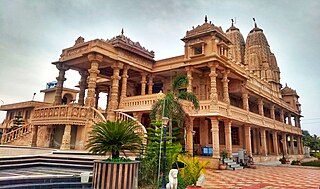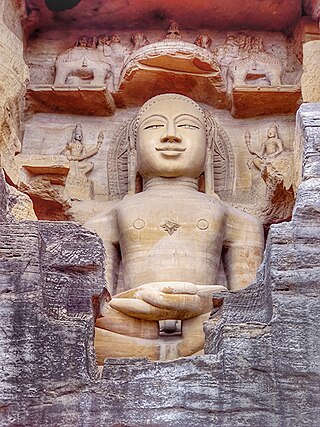
Madhya Pradesh is a state in central India. Its capital is Bhopal, and the largest city is Indore, with Gwalior, Jabalpur, Ujjain, Dewas, Sagar, Satna, and Rewa being the other major cities. Madhya Pradesh is the second largest Indian state by area and the fifth largest state by population with over 72 million residents. It borders the states of Uttar Pradesh to the northeast, Chhattisgarh to the east, Maharashtra to the south, Gujarat to the west, and Rajasthan to the northwest.

The Narmada River, also called the Reva and previously also known as Narbada or anglicised as Nerbudda, is the 5th longest river and overall longest west-flowing river in India. It is also the largest flowing river in the state of Madhya Pradesh. This river flows through the states of Madhya Pradesh and Gujarat in India. It is also known as the "Life Line of Madhya Pradesh and Gujarat" due to its huge contribution to the two states in many ways. The Narmada River rises from the Amarkantak Plateau in Anuppur district Madhya Pradesh. It forms the traditional boundary between North India and South India and flows westwards over a length of 1,312 km (815.2 mi) before draining through the Gulf of Khambhat into the Arabian Sea, 30 km (18.6 mi) west of Bharuch city of Gujarat.

Amarkantak is a pilgrim town and a Nagar Panchayat in Anuppur, Madhya Pradesh, India. The Amarkantak region is a unique natural heritage area and is the meeting point of the Vindhya and the Satpura Ranges, with the Maikal Hills being the fulcrum. This is where the Narmada River, the Son River and Johilla River originate.

Jhalawar is a city, municipal council and headquarter in Jhalawar district of the Indian state of Rajasthan. It is located in the southeastern part of the state. It was the capital of the former princely state of Jhalawar, and is the administrative Jhalawar district. Its district headquarters is Jhalawar. This district is the 22nd largest district of Rajasthan. This district is known by the nicknames of Cherrapunji of Rajasthan, Nagpur of Rajasthan, Brijnagar of Rajasthan etc. Cherrapunji of rajasthan because the highest rainfall in the whole of Rajasthan occurs in manoharthana town in this district. Gagron fort at the confluence of Kalisindh and Ahu river at some distance from Jhalawar It is situated which is one of the Jaldurg of Rajasthan and it is such a fort which is a standing fort without foundation. This fort was included in the UNESCO World Heritage List in 2013.

Acharya Shri Vidyasagarji Maharaj is a Digambara Jain Acharya in present time. He is recognized both for his scholarship and tapasya (austerity). He is known for his long hours in meditation. While he was born in Karnataka and took diksha in Rajasthan, he generally spends much of his time in the Bundelkhand region where he is credited with having brought about a revival in educational and religious activities. He has written haiku poems and the epic Hindi poem "Mukamati".

In Jain cosmology, Chakeshvari or Apraticakra is the guardian goddess or Yakshini of Rishabhanatha. She is the tutelary deity of the Sarawagi Jain community.

Rishabhanatha, also Ṛṣabhadeva, Rishabhadeva, Ṛṣabha or Ikshvaku is the first Tīrthaṅkara of Jainism and establisher of Ikshvaku dynasty. He was the first of twenty-four teachers in the present half-cycle of time in Jain cosmology, and called a "ford maker" because his teachings helped one cross the sea of interminable rebirths and deaths. The legends depict him as having lived millions of years ago. He was the spiritual successor of Sampratti Bhagwan, the last Tirthankar of previous time cycle. He is also known as Ādinātha which translates into "First (Adi) Lord (nātha)", as well as Adishvara, Yugadideva, Prathamarajeshwara, Ikshvaku and Nabheya. Along with Mahavir Swami, Parshvanath, Neminath, and Shantinath, Rishabhanath is one of the five Tirthankaras that attract the most devotional worship among the Jains.

The Ajmer Jain temple, also known as Soniji Ki Nasiyan, is a Jain temple known for its architecture. It was built in the late nineteenth century. The main chamber, known as the Swarna Nagari "City of Gold", has several gold-plated wooden figures, depicting several figures in the Jain religion. This golden chamber of the temple uses 1000 kg of gold to carve out a depiction of Ayodhya.
Sompura Salat are a Hindu Vishwakarma Brahmin community of Gujarat, which have branched off from Sompura Brahmin community. They are also found in southern Rajasthan, specially in the Mewar region. Their origin is said to be from Prabhas Patan famous for the Somnath temple. The term "salat" is derived from Shilavat, the old term for a temple architect.

Muni Tarun Sagar was an Indian Digambara monk. His lectures are termed Kadve Pravachan because they can be candidly critical of common practices and views. His lectures have been compiled and published in book series also titled Kadve Pravachan. Excerpts from his discourses are often published by newspapers. Unlike most other Digambar Jain monks, his audience often included a majority of non-Jains. His discourses often addressed family or society issues.

Shri Digamber Jain Prachin Bada Mandir is a Jain temple complex located in Hastinapur, Uttar Pradesh. It is the oldest Jain temple in Hastinapur dedicated to Shri Shantinatha, the 16th Jain Tirthankara.

Upadhyaya Shri Guptisagarji is a Digambara monk who currently has the rank of an Upadhyaya. Born in 1957, he took ailak diksha under Acharya Vidyasagar ji in 1980, Muni diksha in 1982 also under Acharya Vidyasagar. He was initiated an Upadhyaya by Acharya Vidyanand ji in 1991. He is the inspiration behind Gupti Dham Jain Mandir, Ganaur, Sonipat.

Trilok Teerth Dham is a Jain temple in Bada Gaon, Baghpat, Uttar Pradesh, India.

The Gopachal rock-cut Jain monuments, also called Gopachal Parvat Jaina monuments, are a group of Jain rock-cut carvings dated to between the 7th and 15th centuries. They are located around the walls of the Gwalior Fort, Madhya Pradesh. They depict Tirthankaras in seated Padmasana posture as well as standing Kayotsarga posture, in the typical naked form of Jain iconography.

Shri Nageshwar Parshwanath Tirth or Shri Jain Shwetamber Nageshwar Parshwanath Tirth Pedhi is a Jain Temple situated in Unhel, Jhalawar district, Rajasthan. This temple is dedicated to Parshvanatha, the 23rd Tirthankar.

Bade Baba Temple, Kundalpur is a temple in Kundalpur, a pilgrimage town for Jains, in Damoh district of Madhya Pradesh. It is 35 km from Damoh. The Bade Baba Temple was formally known as Shri Digamber Jain Siddha Kshetra Kundalpur.

Pisanhari ki Marhia is a Jain temple built in the 15th century and located in the city of Jabalpur in Madhya Pradesh, India. The temple is named after its creator, a local woman who, according to legend, paid for the construction of the temple with the money she saved from milling flour. Many other temples have since been added making this a tirtha.
Thakur Zorawar Singh Barhath was an Indian revolutionary and independence activist. He is known for the assassination attempt on the Viceroy of India, Lord Hardinge, by throwing a bomb at him during a procession in New Delhi.
Chetavani ra Chungatya is a patriotic Dingal poem composed by Thakur Kesari Singh Barhath in 1903 and addressed to Maharana of Mewar, Fateh Singh, exhorting him to uphold the traditions of his lineage and to not attend the Delhi Durbar. The couplets had the desired effect on the Maharana who decided not to attend the durbar despite being present in Delhi. The work remains one of the great literary works produced during the freedom struggle. It consists of 13 stanzas or sortha (saurashtra-duha).




















